This is your one-stop guide to everything on Shubunkin Goldfish, including care tips, its varieties, feeding, breeding, tank setup, and much more.

Meet the Shubunkin Goldfish
Today, we dive into the world of a beautiful pet with striking calico patterns of red, white, blue, and orange colors – the Shubunkin goldfish.
Having origins in Japan, it has developed varieties such as the Bristol Shubunkin, London Shubunkin, and American Shubunkin. This slender body, single-tailed fish is a popular aquarium fish loved for its coloration, longevity, and patterns. The Shubunkin patterns have black spots or patches on a metallic blue or gray background.
In this article, we’ll explore the varieties of the Shubunkin goldfish, how to nurture them, and the common illnesses of the Shubunkin goldfish.
For more information on goldfish breeds check out our article on the 15 Types of Goldfish for your Aquarium.
History and Origin of Shubunkin Goldfish

The Shubunkin origin dates back to the early 1900s in Japan. Breeders developed it through selective breeding of the Calico Telescope Eye and Calico Veil Tail goldfish species.
It has since become popular as a Japanese goldfish.
Over the years, breeders have focused on enhancing color clarity and distribution by refining the body shape to maintain a balanced appearance.
Selective breeding also improved the overall health and resilience of the Shubunkin, making it a hardy and adaptable fish suitable for various aquatic environments, including ponds and aquariums.
Unique Characteristics of Shubunkin Goldfish
Like other goldfish, there are several unique Shubunkin traits, and I’ll draw out some of them so you can easily tell whether you’re looking at our calico friend or just another beautiful fish.
- Calico Coloration: They sport a striking calico pattern with patches of red, orange, blue, black, and sometimes white. This mosaic of colors gives them a unique and vibrant appearance, setting them apart from solid-colored goldfish varieties and earning them the name calico goldfish.
- Active Swimmers: These goldfish are active and agile swimmers, often exploring all levels of the aquarium or pond. Their energetic nature adds liveliness to aquatic environments.
- Longevity: With proper care, Shubunkin Goldfish can live for 10 to 15 years or more, showcasing their robust health and longevity compared to other fish species.
- Hardiness: Shubunkins are exceptionally hardy goldfish known for their resilience and ability to thrive in various water conditions. They can tolerate various temperatures and water parameters, making them well-suited for beginner and experienced fish keepers.
Shubunkin Goldfish are prized for their stunning calico patterns, hardy nature, active behavior, and long lifespan, making them popular for aquariums and outdoor ponds. These shubunkin characteristics make them one of the most popular varieties of the Japanese goldfish.
Types of Shubunkin Goldfish
Remember I told you earlier that this multi-color goldfish comes in various varieties? It’s time to analyze the variety of Shubunkin and help you identify them!
American Shubunkin

This comes in a streamlined body with a slightly elongated torpedo-like form. They typically have moderate finnage that complements their sleek body shape and generally grow to a moderate size, making them suitable for outdoor ponds and larger aquarium setups.
American Shubunkins are known for their hardiness and adaptability, thriving in a variety of water conditions and temperatures.
They are popular among goldfish enthusiasts for their striking appearance and active behavior, making them a valued addition to both beginner and experienced aquarists alike.
London Shubunkin

The London Shubunkin typically have a streamlined and elongated body shape, similar to the American Shubunkin with the classic calico feature that we love.
They display a balanced and harmonious blend of these colors across their bodies and do not typically have extremely long fins. They grow to a moderate size, making them suitable for outdoor ponds as well as larger aquariums.
London Shubunkins are social fish and do well when kept in groups.
Bristol Shubunkin

The Bristol Shubunkin is a distinct variety known for its unique finnage and coloration.
They generally have a streamlined body shape, similar to other Shubunkin varieties, but with longer and flowing fins. Their tail fins are particularly notable for their elongated, ribbon-like appearance, which trails behind them gracefully as they swim.
They grow to a moderate size and exhibit typically well-defined and distributed calico color patterns.
The Bristol Shubunkin’s striking appearance, with its long, flowing fins and vibrant coloration, makes it a popular choice among goldfish enthusiasts who appreciate the beauty and grace of fancy goldfish varieties.
Ideal Tank Conditions for Shubunkin Goldfish
Now we’re getting into more technical specifics on maintaining Shubunkin goldfish, so pay attention, aqua lovers. We’ll review what you need to get going on your Shubunkin tank setup.
- Tank Size: The lovely ‘calico’ fish are active swimmers that can grow quite large, requiring a spacious tank. A minimum tank size of 30 gallons (113 liters) is recommended for a single Shubunkin, with an additional 10 gallons (38 liters) per fish to accommodate their size and swimming behavior.
- Water Parameters: Shubunkins are coldwater fish, so you must maintain temperatures between 65-75°F (18-24°C). Keep the temperature stable, as constant fluctuations may negatively affect the fish. Other water parameters include pH (7.0-8.4 is preferable), Ammonia, and Nitrite levels.
Without maintaining proper water parameters, the tank’s water quality can degrade, which can cause a wide range of issues from cloudy aquarium water to illness and mass fish die off. - Filtration: Shubunkins have messy eating habits and high biological loads, so your filtration system is very important. A good quality filter rated for at least 8-10 times the tank volume per hour is recommended. Mechanical and biological filtration are important to remove waste and maintain ideal tank conditions and a healthy environment.
- Decoration: Shubunkins need ample swimming space, so whatever decoration you choose should not interfere with their space. You could include live or artificial plants for cover and oxygenation. Be careful not to use sharp decorations that could injure the fish.
Maintaining a clean and stable environment is crucial for the health and longevity of Shubunkin Goldfish. With proper tank size, water parameters, filtration, and regular maintenance, you can provide a thriving habitat for these beautiful and active fish.
Feeding and Nutrition for Shubunkin Goldfish
Shubunkin Goldfish require a balanced and adequate diet for their health and overall well-being. Here are some tips for their nutrition.
Types of Food
Quality goldfish food or flakes should form the staple of their diet. Use varieties specifically formulated for goldfish, as they contain the essential nutrients and vitamins.
Occasionally, you could include treats of live or frozen foods like bloodworms, daphnia, or tubifex worms to provide variety and protein.
We recommend these Gold Fish Pellets:
For more on feeding your aquatic pets check out The Ultimate Guide to Fish Food: Pros and Cons & Best Choices!
Feeding Frequency
You mustn’t overfeed your Shubunkin, so keep meals to only once or twice a day, offering only what they can consume in 2-3 minutes.
Pay attention to the feeding behavior and adjust the meal amount or frequency accordingly.
Nutritional Needs
Shubunkins require a balanced diet with a moderate protein content to support growth and maintenance. They also need fiber and essential vitamins such as Vitamin C from vegetables and fruits.
Minerals also help with bone and scale health, so consider this when meal-prepping for your fish!
Other notable feeding and nutrition tips
Offering a variety of food is essential for your Shubunkin diet. It helps to prevent nutritional deficiencies and keep them engaged.
Feed in small amounts to prevent food from settling uneaten and fouling the water.
Remove any uneaten food after feeding to maintain water quality.
Adjust feeding amounts and frequency based on seasonal changes. Shubunkins may eat less during colder months when their metabolism slows down.
Feeding Shubunkin goldfish is a process that should be done intentionally and carefully to preserve them.
Lifespan and Growth
On average, the Shubunkin’s lifespan is about 10-15 years, and like regular goldfish growth, the Shubunkin grows rapidly in its first year and slows down as it ages, reaching a size between 5 and 8 inches.
Factors affecting Shubunkin longevity
- Proper care
- Water quality
- Diet
- Genetics
- Environment
- Healthcare practices are
Factors affecting Shubunkin size
- Water temperature
- Diet
- Available space
Compatibility With Other Fish
Now you’ve set up your aquarium, and you’re wondering whether you can add other fish to your aquarium setup and what fish are the perfect shubunkin tank mates. This portion of the article briefly reviews compatible fish species.
Common Goldfish and Shubunkin Goldfish
Other Goldfish Varieties, like the common and comet goldfish, are perfect companions for the Shubunkin as they have similar tank requirements and temperament.
This setup will be such a beauty to behold. You have the opportunity to create your own little beautiful goldfish community tank.
White Cloud Mountain Minnows and Shubunkin Goldfish
White Cloud Mountain Minnows are small, peaceful fish that thrive in water conditions similar to the shubunkin goldfish.
Weather Loach and Shubunkin Goldfish
Weather Loach are bottom-dwelling fish that generally get along well with goldfish and help keep the tank clean.
As peaceful and generally compatible as Shubunkin goldfish is, some fish may not be compatible with it. Some of such fish include:
Tropical fish require warmer water than goldfish, making them not good tankmates.
Aggressive fish, such as cichlids, to prevent bullying or stress.
If you successfully select compatible tank mates and provide a suitable environment, Shubunkin Goldfish can thrive alongside other species, enriching the aquarium’s beauty and activity. However, when pairing fish, you must always consider fish compatibility, tank size, and water conditions.
Breeding Shubunkin Goldfish
Breeding Shubunkin Goldfish involves several key steps to ensure successful reproduction and care for the offspring (fry). This guide is a goldfish breeding tell-all that any aqua lover can use!
How to Identify Breeding Pair
This stage is very important. You should choose mature, healthy fish at least 1-2 years old and free from visible signs of disease or deformities.
Also, go for fish with vibrant colors and well-formed bodies, typical of Shubunkins.
Lastly, go for males who display breeding behavior, such as chasing females, and courtship behaviors, like nudging and circling.
Prepare the Breeding Tank

Use a separate breeding tank with at least 20 gallons (75 liters) to provide ample space for breeding activities and fry development.
The temperature and pH should be maintained at a conducive, stable parameter, and a gentle filtration device should be used. You should provide fine-leaved plants or spawning mops in spawning sites.
Use marbles or a bare bottom in a breeding tank set up to prevent eggs from being eaten.
Caring for the Fry
The egg is laid at this stage, and you are worried about Shubunkin fry care. Don’t worry I’ve got you covered.
To successfully become a fish parent, maintain stable water conditions and adequate aeration. Feed newly hatched fry with infusoria or commercial liquid fry food upon hatch.
Gradually introduce finely powdered or crushed flake food as they grow. Perform small, frequent water changes to maintain water quality and remove uneaten food and waste.
Monitor fry growth and separate larger fry from smaller ones to prevent cannibalism. Provide ample hiding places and maintain consistent care routines.
Common Health Issues and Treatment
Goldfish diseases, like other types of animal diseases, are serious business that should be paid attention to. Although our calico-colored friends are generally hardy fish, they can still encounter several common health issues. Here are some Shubunkin health issues and advice on prevention, treatment, and when to seek veterinary care:
Swim Bladder Disorder
Swim bladder disorder (SBD) is a common health issue that affects fish, including Shubunkin Goldfish.
The swim bladder is an internal gas-filled organ that helps fish regulate buoyancy and maintain their position in the water column. When the swim bladder malfunctions or becomes affected by disease or injury, it can disrupt the fish’s ability to swim properly.
Signs: Difficulty maintaining buoyancy, observed by the fish either floating uncontrollably or sinking to the bottom frequently. Fish may also swim in abnormal positions (head/tail up or down).
Prevention: Avoid overfeeding and ensure a varied diet. Provide sinking pellets to minimize air intake while feeding.
Treatment: Feed a diet high in fiber and adjust feeding practices to prevent future issues. Seek veterinary care if symptoms persist despite dietary adjustments or if the fish appears distressed.
Fungal and Bacterial Infections
Various fungi, such as Saprolegnia and Achlya species, cause fungal infections in fish. These fungi are typically present in aquatic environments but can increase and cause infections when fish are stressed or injured. Common sources of stress include poor water quality, physical trauma, or other underlying health issues.
Signs: White patches, fuzzy growths, redness, or inflammation on the body, fins, or gills. Behavior changes such as sluggishness or loss of appetite.
Prevention: Maintain excellent water quality through regular water changes and effective filtration. Avoid overcrowding.
Treatment: Use aquarium salt baths or antifungal medications as directed. Quarantine affected fish to prevent spreading.
If infections worsen or multiple fish are affected simultaneously, seek veterinary care!!
Ammonia/Nitrite Poisoning
Ammonia and nitrate poisoning harms Shubunkin goldfish, as is the case for other fish. This may come into the aquarium from fish waste products.
Signs: Fish may gasp at the water surface and exhibit reddened gills, lethargy/sluggishness, or reduced appetite.
Prevention: Regularly test water parameters and perform partial water changes to keep ammonia and nitrite levels at zero.
Treatment: Immediately perform a large water change to dilute toxins. Ensure proper filtration and aeration. Seek veterinary care if fish show severe distress or if multiple fish are affected simultaneously.
Regularly monitoring your Shubunkin Goldfish’s behavior, appetite, and physical appearance is essential. Early detection of symptoms and prompt intervention can greatly improve the chances of successful treatment.
If unsure about diagnosis or treatment, consult a qualified aquatic veterinarian who can provide specific guidance tailored to your fish’s needs.
Conclusion
Slowly but surely, our calico friend episode is wrapping up. However, remember these about our friend-
The shubunkin goldfish is a pretty, active fish that, by its nature, requires close care and attention to keep it healthy and fit. So, if you want to enjoy this multi-colored friend of ours for as long as 15 years, which it can survive, ensure you follow the tips in this guide. Avoid overfeeding, use good filters, and get prompt medical assistance once you notice anything wrong.
Responsible fishkeeping is about dedication to the cause and paying attention to your pet fish for signs of trouble. Because nipping health problems in the bud early is better than attempting later damage control.



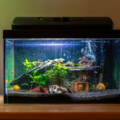
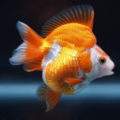
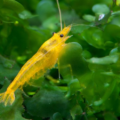

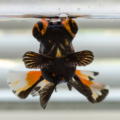
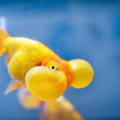



1 thought on “Shubunkin Goldfish Care Guide: Varieties, Tank Setup, and More”